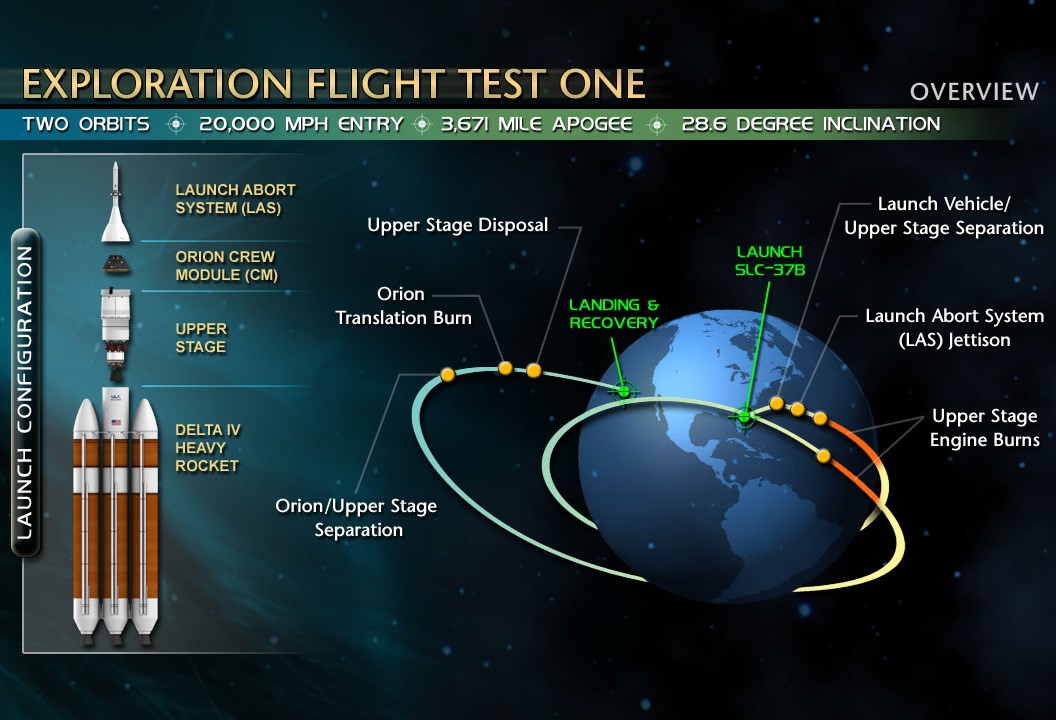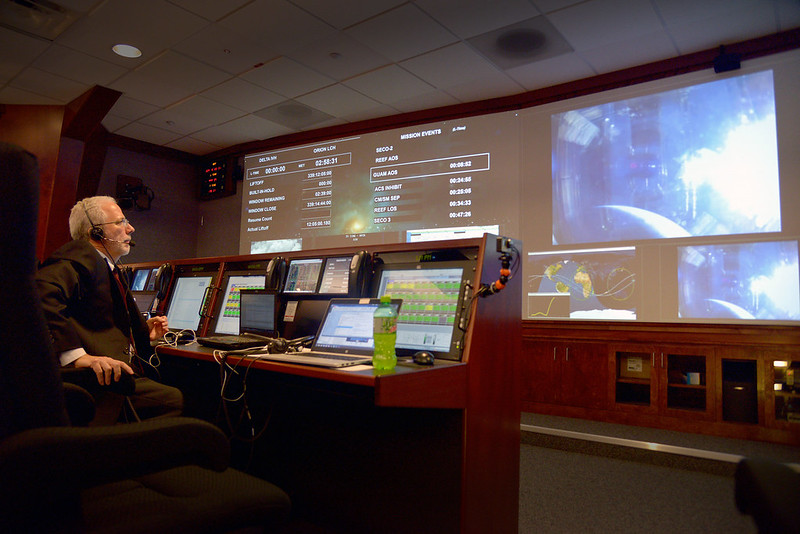Just Five Years Ago! Orion Flies its First Mission
America’s spacecraft capable of carrying humans deep into space made its first foray beyond Earth on Dec. 5, 2014. Orion is the vehicle NASA is building to take American astronauts back to the Moon and eventually beyond and is a key part of the agency’s Artemis program. Orion’s first mission, called Exploration Flight Test-1 (EFT-1), in many ways recalled the November 1967 Apollo 4 mission, the first all-up test flight of that program.
For this first test flight, Orion used a Delta-IV Heavy booster, at the time the most powerful operational rocket. The 4.5-hour mission demonstrated Orion’s space-worthiness, tested the spacecraft’s heat shield during reentry into the Earth’s atmosphere and proved the capsule’s recovery systems. Although EFT-1 didn’t include a crew, the Orion capsule flew higher and faster than any spacecraft meant to carry humans in more than 40 years. The test flight carried a high-fidelity crew module and a mock service module that remained attached to the rocket’s upper stage.

At 7:05 a.m. EST on Dec. 5, 2014, the three-core first stage of the Delta-IV heavy rocket ignited, lifting the Orion spacecraft off from Launch Complex 37B at Cape Canaveral Air Force Station to begin EFT-1. Three minutes and 58 seconds after liftoff, the two side boosters separated as the center core continued firing for another 93 seconds. The second stage ignited 13 seconds after separation to begin the first of three planned burns. During this first burn, the Service Module’s protective fairing separated, followed by the Launch Abort System. Lasting about 11-and-a-half minutes, this first burn of the second stage placed the spacecraft into a preliminary 115-by-552-mile parking orbit.
After completing one revolution around Earth, during which time controllers in the Mission Control Center in Houston, led by Flight Director Michael L. Sarafin, verified the functioning of the spacecraft’s systems, the second stage ignited a second time, firing for 4 minutes and 42 seconds to raise Orion’s apogee, or high point, above Earth to 3,600 miles. During the coast to apogee, Orion remained attached to the second stage and completed its first crossing through the inner Van Allen radiation belt.

As Orion reaches an apogee of 3,600 miles, Orion Program Manager Mark Geyer watches the view from Orion's windows. Image Credit: NASA/Radislav Sinyak
Three hours and five minutes after launch, Orion reached its apogee and began its descent back toward Earth, separating from the second stage about 18 minutes later. The second stage conducted a one-minute disposal burn to ensure it didn’t interfere with the spacecraft’s trajectory. During passage back through the Van Allen belt, Orion fired its thrusters for 10 seconds to adjust its course for re-ntry. At an altitude of 400,000 feet, the spacecraft encountered the first tendrils of Earth’s atmosphere at a point called Entry Interface, traveling at 20,000 mph. A buildup of ionized gases caused by the re-entry heating resulted in a communications blackout with Orion for about two-and-a-half minutes.
During reentry, the spacecraft experienced maximum heating of about 4,000 degrees Fahrenheit, proving the worthiness of the heat shield. After release of Orion’s forward bay cover, two drogue parachutes deployed to slow and stabilize the spacecraft. Next followed the deployment of three main parachutes that slowed the spacecraft to 20 mph. Splashdown occurred four hours and 24 minutes after launch, about 600 miles southwest of San Diego, California.
Left: View of Earth taken by a remote camera aboard Orion during EFT-1. Middle: The Orion capsule under its three main parachutes moments before splashdown in the Pacific Ocean. Right: NASA Administrator Charles Bolden (left) and NASA Associate Administrator for Human Exploration and Operations Bill Gerstenmaier monitor Orion’s splashdown from a control room at Cape Canaveral.
Standing by to recover the Orion capsule, U.S. Navy divers assigned to Explosive Ordnance Disposal Mobile Unit 11 and Fleet Combat Camera Pacific, and crew members from amphibious transport dock USS Anchorage, stepped into action, first placing a flotation collar around the spacecraft. After securing a tow line to the capsule, the sailors towed it aboard the amphibious well deck of Anchorage, which set sail for Naval Base San Diego—later arriving there on Dec. 8. Engineers from NASA and Lockheed Martin conducted a preliminary inspection of the spacecraft during the cruise to San Diego, finding that it had survived its trip into space in excellent condition.
Left: U.S. Navy divers approach the Orion capsule during recovery operations. Image credit: U.S. Navy. Right: Personnel guide Orion into the well deck of USS Anchorage. Image credit: U.S. Navy.
The Orion EFT-1 mission met all its objectives and received many accolades.
“Today was a great day for America,” said Sarafin from his console in mission control.
“It is hard to have a better day than today,” remarked Orion Program Manager Mark S. Geyer.
“We’re already working on the next capsule,” said W. Michael “Mike” Hawes, Lockheed Martin’s Orion program manager, adding, “We’ll learn a tremendous amount from what we did today.”
NASA Associate Administrator for Human Exploration and Operations William H. Gerstenmaier praised all personnel involved with the EFT-1 mission, saying, “What a tremendous team effort.”
“Today’s flight test of Orion is a huge step for NASA and a really critical part of our work to pioneer deep space,” said NASA Administrator Charles F. Bolden, summarizing his thoughts about the mission.
Left: Bolden (in red tie) inspects the Orion EFT-1 capsule at NASA’s Kennedy Space Center. Right: The EFT-1 capsule on display at Kennedy’s Visitors Center. Image Credits: NASA
After its arrival at Naval Base San Diego, workers placed the Orion capsule aboard a truck that delivered it to NASA’s Kennedy Space Center on Dec. 18. After engineers conducted a thorough inspection of the spacecraft, workers trucked it to the Lockheed Martin facility in Littleton, Colorado, where it arrived on Sept. 1, 2015. Engineers there completed final inspections and decontamination of the vehicle. The capsule can now be found on display at the Kennedy Visitors Center.
The next time an Orion spacecraft flies in space, during the Artemis I mission, the Space Launch System will carry it into orbit after launch from Kennedy’s Launch Complex 39B. The first in a series of increasingly complex missions, Artemis I will provide a foundation for human deep space exploration and demonstrate our commitment and capability to extend human existence to the Moon and beyond. The uncrewed Orion spacecraft will spend approximately three weeks in space, including six days in a retrograde orbit around the Moon. Engineers at Kennedy mated the Artemis 1 crew module with its service module in July 2019 and shipped it to NASA Glenn Research Center’s Plum Brook Station in Sandusky, Ohio, for vacuum testing beginning in December 2019.
Left: Artemis program patch. Right: Completed Artemis 1 spacecraft about to undergo vacuum chamber testing at Plum Brook Station. Image Credits: NASA










